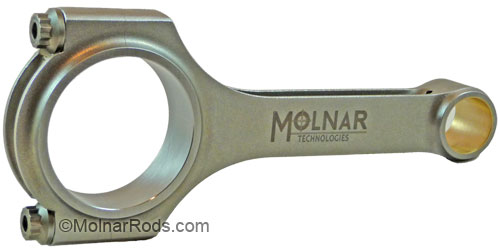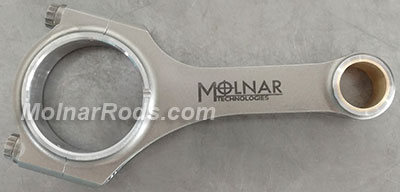Quite frequently the question of Molnar rods hp rating is brought up so we want to share some information that people interested in this can learn from and become better informed regarding connecting rods ratings in general. There is really no one set horsepower rating for any particular rod as many other factors affect the durability of a con rod.

The below information comes from Tom Molnar, the owner of Molnar Technologies. He wrote the below to help people better understand the forces acting on a connecting rod in a modern high performance engine and give some insight into why you will not see a specific Molnar rods hp rating. This is a brief discussion of connecting rods in the very dynamic situations they encounter and we hope you will find it helpful and maybe even spark your interest enough to research the matter further. Since the introduction of the extreme duty series we are also asked about the Molnar power adder rods hp rating and this discussion applies to those rods as well. This info quoted from Mr. Molnar is also available in the Molnar Technologies print catalog.

"We are often asked about horsepower ratings on connecting rods. We all know power is created by the expanding gasses pushing on the piston, which in turn pushes on the connecting rod and the energy is used to rotate the crankshaft. There are situations where a rod can break due to these compressive forces however, the loads on a connecting rod are actually more complex than this. These loads include, but are not limited to, unequal forces from wrist pin distortion, excessive bearing clearances, detonation, improper oiling, and tensile loading by the piston at TDC of the exhaust stroke. If you look closely at a broken rod, in most cases you will find it is not crushed from the power cycle and is actually pulled apart from the tensile load. RPM, stroke, piston/pin weight and rod length all affect the tensile load that is placed on the rod. Typically, performance engines are operated at an RPM that is well above peak power. This low power/ high RPM situation may be an accidental over rev, at the end of a straight away, when the throttle is closed going into a corner or at the end of the drag strip. It is at these elevated revs that the rod will likely become over stressed and ultimately lead to a failure.

Since the causes of rod failures typically occur at power levels that are not at peak power, the question comes up as to why power ratings are used to rate rods. The answer is that they are a simplistic way to deal with a complicated issue since compressive and tensile loads generally increase with increased power. However, power ratings are not the only thing to consider when making a connecting rod selection. Don’t be fooled by people who provide a simple power rating to sell you parts. At Molnar Technologies we look at your total engine package and work with you to help insure you get the right parts for your application."
This concludes our quick discussion about Molnar rods hp rating and why you do not see specific numbers listed for them as you sometimes do for other brands of connecting rods.